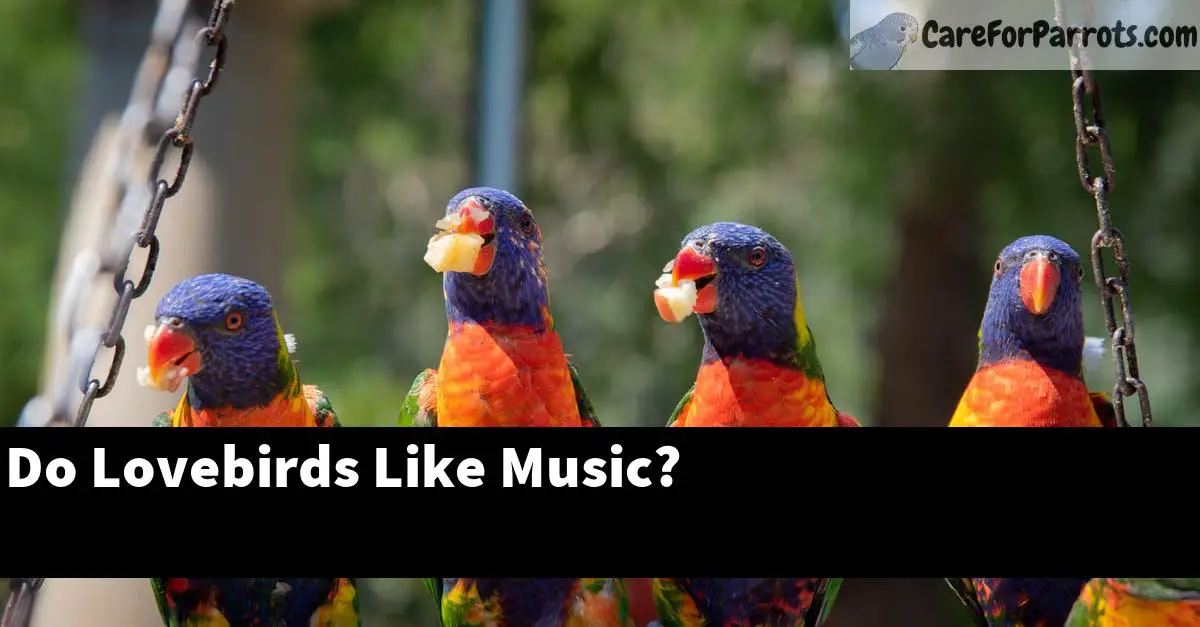We’ve all heard of the soothing effect music has on humans, but did you ever stop to wonder if our feathered friends share the same sentiment?
In this article, we will delve into the world of lovebirds and their affinity for music. We will explore how music impacts their behavior, ways to introduce music to your lovebird, and the potential benefits of exposing them to various tunes.
The answer to whether lovebirds enjoy music is not a simple yes or no, as individual preferences and reactions may vary. However, many lovebird owners have observed the positive effects of music on their pets. Curious about how to incorporate music into your lovebird’s life? Keep reading to learn more.
Table of Contents
Lovebirds’ Reaction to Music
Positive Responses to Music
Lovebirds, like other parrots, are intelligent and social creatures. They are known to respond well to various stimuli, including music. Many lovebird owners have observed their pets becoming more active, vocal, and even appearing to dance when exposed to music. Some lovebirds may even mimic the rhythm or melody of the songs they hear.
Negative Responses to Music
While many lovebirds respond positively to music, not all of them do. Some may become agitated, stressed, or even aggressive when exposed to certain types of music or loud volumes. As a responsible lovebird owner, it’s essential to monitor your pet’s reaction and adjust the music accordingly.
Choosing the Right Music for Your Lovebird
Volume and Type of Music
Selecting the right type of music for your lovebird is crucial. In general, softer, calming tunes are preferable, as loud or chaotic music can potentially stress your pet. It’s essential to start with a low volume and gradually increase it while observing your lovebird’s reaction.
Experiment with Different Genres
Since individual lovebirds may have unique preferences, it’s a good idea to experiment with different genres of music. Classical, instrumental, and soft jazz are popular choices among lovebird owners. However, some lovebirds may enjoy more upbeat tunes like pop or rock, as long as the volume is kept in check.
Duration and Frequency
It’s essential not to overdo it when exposing your lovebird to music. Playing music for a few hours a day should be more than enough to provide stimulation without overwhelming your pet. Also, make sure to vary the music you play to prevent boredom.
Matiniy 2 Pcs Pirate Parrot on Shoulder Life Sized Artificial Parrot Toy for Costume Dress-up Accessory for Halloween Party(Multicolor)
$14.99 (as of 21/12/2025 07:48 GMT +03:00 - More infoProduct prices and availability are accurate as of the date/time indicated and are subject to change. Any price and availability information displayed on [relevant Amazon Site(s), as applicable] at the time of purchase will apply to the purchase of this product.)Bird Toys, Parrot Toys for Large Birds,Natural Corn cob and Loofah Slices Bird chew Toys for African Grey Parrots, Macaws, Cockatoos, Amazon Parrot and other Small and Medium-Sized Parrot (Colorful)
$12.97 ($12.97 / count) (as of 21/12/2025 11:07 GMT +03:00 - More infoProduct prices and availability are accurate as of the date/time indicated and are subject to change. Any price and availability information displayed on [relevant Amazon Site(s), as applicable] at the time of purchase will apply to the purchase of this product.)Kaytee Fiesta Parrot Food, Nutritious and Fun Blend, Supports Skin, Feather, Digestion, Brain and Heart Health, 4.5 pounds
16% OffBenefits of Music for Lovebirds
Mental Stimulation
Providing mental stimulation is crucial for the well-being of your lovebird. Exposure to music can offer enrichment, helping to prevent boredom and alleviate stress. Music can also encourage vocalization and even inspire your lovebird to mimic the sounds they hear.
Bonding Opportunity
Playing music for your lovebird can be an excellent bonding opportunity. Singing or dancing along to the music can help strengthen the bond between you and your pet, while also providing entertainment and mental stimulation.
Reducing Separation Anxiety
Many lovebirds experience separation anxiety when left alone for extended periods. Playing soft, calming music while you’re away can help soothe your pet and make them feel less anxious.
Conclusion
In conclusion, while lovebirds’ reactions to music can vary, many of them do enjoy various tunes. By carefully selecting the right type of music and paying attention to your lovebird’s response, you can create a fun and enriching environment for your pet.
Music has the potential to offer mental stimulation, strengthen the bond between you and your lovebird, and reduce separation anxiety.
FAQ
Q: Can lovebirds learn to sing songs? A: Lovebirds are not known for their ability to sing songs like some other parrot species, but they can mimic rhythms and melodies to some extent.
Q: What volume should I play music at for my lovebird? A: It’s best to start with a low volume and gradually increase it while observing your lovebird’s reaction. Make sure the music is not too loud, as it can cause stress for your pet.
Q: Can I leave the music on for my lovebird when I’m not at home? A: Yes, you can leave soft, calming music playing for your lovebird when you’re not at home. This can help reduce separation anxiety and provide a sense of comfort for your pet.
Q: How often should I play music for my lovebird? A: Playing music for a few hours a day should be sufficient to provide mental stimulation without overwhelming your lovebird. Make sure to vary the music you play to prevent boredom.
Q: Can lovebirds develop a preference for certain types of music? A: Individual lovebirds may develop preferences for specific genres or songs. Experiment with various genres and observe your lovebird’s reaction to find the type of music they enjoy the most.
























